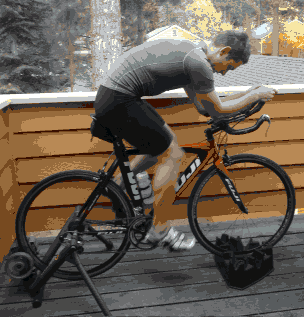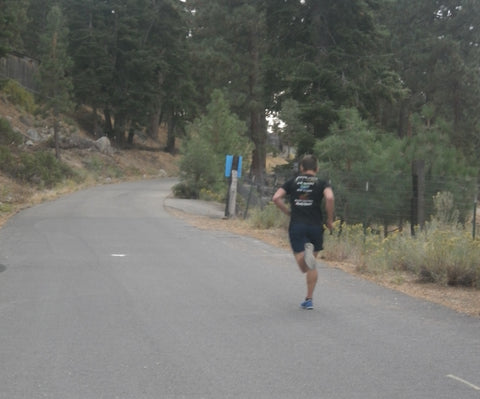Our Top 5 Off-Season Triathlon Workouts!
When a triathlete is in their off season several months away from a triathlon, the goal is to build a solid foundation of fitness to build race specific speed for later. The following workouts are Triathlon Coach Brad Haag's top 5 personal favorite workouts that give triathletes the most “bang for your buck” or improvement for the time invested. Try implementing these into your off season routine to take your triathlon performance to the next level come race day.
1. Bike Tabata intervals on an Indoor Trainer: This workout is perfect to break up the off season boredom. Instead of spending hours in the bike saddle building endurance, you can get the same benefit from doing this 30-45min workout on the spin bike at the gym after a swim session, or in the convenience of your home on a bike trainer after work.

The Workout: Warm-up 20 minutes. Then move on to your Tabata set: complete 20 seconds hard, 10 seconds easy for a total of 4 minutes. The 20 second efforts must be as hard as possible. Recover easy for 10 minutes. Repeat the Tabata set one more time, then cool-down with easy spinning.
2. Run Hill Climbs: in order to establish a solid off season foundation, triathletes need to invest training in running force application and strength. This workout is designed to provide both.

The Workout: Find a steep hill (type of hill you would normally "hike" not "run"). Run up the hill in a controlled fashion, focusing on force application and pushing through each stride. This is a focus on strength and power. Run for 45-90 seconds. The recover is the walk back down. If weather does not permit outdoor running, you can instead perform this workout on a steep treadmill or on a stair climber. Goal is 8-10 repeats. Choose more repeats and a longer hill for Half-Iron to Iron distance.
3. Triathlete Suspension Trainer Workout: The off season is the perfect time to build up your muscular strength and core. A suspension trainer allows you to perform exercises while constantly engaging your core. Suspension trainers are now more affordable than ever and can be set up in a doorway, around a tree, or any stable loop that supports your body.
The Workout: Warm-up: 3-5min aerobic bike or run. Then 25 jumping jacks or 5min of jump rope. Do 10 pushups, 10 squats, 10 side lunges. Complete the following sequence of exercises as a circuit 3-4x through, with minimal rest between exercises.
- Atomic Push-ups 8-10 reps
- Single Leg Lunge w/high knee 8-10 reps
- Suspension Plank Reaches 8-10 reaches each side
- Squat with row 8-10 reps
- Sprinter starts 8-10 reps
- Swimmers pull 8-10 reps
Cool down with some light activity such as a jog around the block or bike to the store.
4. Off Season Force Skills Swim: Swimming is a discipline of triathlon that requires constant attention year-round. In the off-season swim workouts should focus on building force to slide through the water with ease and attention to building your water speed skills. This easy workout is perfect for building the force you need while also including technique specific drills.

The Workout: Warm-up with 300 (meters or yards depending on the pool you’re in) of easy swimming, then put on paddles or use pull buoy if available. Swim 25m with the left arm only, then 25m back with the right arm only, then swim 50m with both arms at a fast pace. Rest 10-20 seconds. Repeat 6x. Focus on pulling through the water with a high elbow and bent arm. After these repeats remove the paddles and/or pull buoy and do a 200-400m Tempo swim at race pace. Cool down with 100m of backstroke and 200m of easy swimming.
5. High Cadence Bike Spin: Biking during the off season can be somewhat tricky with the winter whether. I recommend this workout that can be done on an indoor trainer to upbeat music, or on a mountain or cyclocross bike outside. This bike workout will train your body to increase muscle recruitment and pedal more efficiently.

The workout: Ride for 45-90 minutes (choose longer time for Half-Iron to Iron distance training) at a cadence of 90-100RPM, no slower. Use a gear that has you breathing deeply for the ride, but without the legs burning so much that cadence slows. If you cannot maintain the RPM for the full time, split this into 10 minute high RPM efforts separated by 1-2 minute recovery periods.
Brad Haag, Professional Triathlon and Cycling Coach
Brad is a USA Cycling Level III-certified coach, NCSF-certified personal trainer, certified-indoor cycling instructor, and a graduate of Ben Greenfield’s Superhuman Coach Program. Brad’s coaching career began while he was still in the Navy when he held the position of Command Fitness Leader (the Navy’s version of a Personal Trainer). Brad has also qualified for Triathlon Nationals in three different distances (Sprint, Olympic, and Half-Ironman). You can follow Brad on Twitter and Facebook.
Also in Blog

Dropping Unnecessary Sugars In Your Sports Drink Is Easy
We need to hydrate. But how can you hydrate and replace electrolytes without the harmful additives like sweeteners and artificial flavoring common in sports drinks that are harsh on your stomach?
